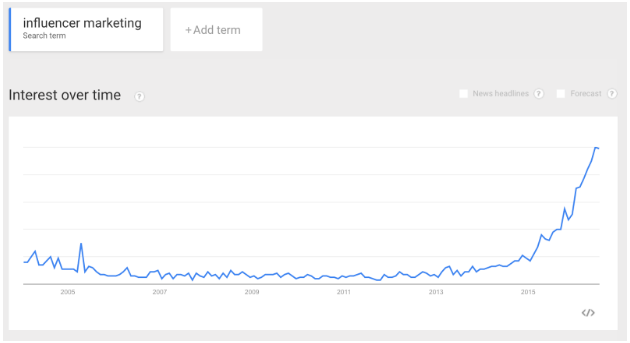ProBlogger: How to Pitch Brands When You Have Low Traffic | |
| How to Pitch Brands When You Have Low Traffic Posted: 28 Jul 2016 07:00 AM PDT A common question from new bloggers is "How big do I have to be before I can start working with brands?" It's a question that reveals how often emphasis is put on audience size when it comes to marketing spend in the influencer space. There are definitely ways you can change this emphasis to work for, rather than against you. It's important to understand that audience size is a carryover from traditional advertising and media buying – the more eyeballs the better! Digital marketing makes it easier and cheaper to reach more eyeballs than ever before (hello Facebook ads). It's no wonder people are fed up with and becoming blind to advertising messages. We now prefer, more than ever, 'word of mouth' recommendations from people we know and trust to help us filter and make decisions on how we act and what we purchase. I just received an email this morning informing me of the rise in the search term 'influencer marketing' – quite the spike in the last 12 months! This is great news for you if you're an influencer. Note the search term is for 'influencer marketing', not 'massive website marketing' or 'how to market to fake Instagram followers'. So, when it comes to your strategy for approaching brands when you have low traffic, worry less about the size of your audience and start focusing on the impact of your influence on that audience. It's your influence you need to emphasise to the brands you want to work with. If you need to figure out if you've got influence, check out The 4 Rs that Show a Brand your Blog is Influential. Here are 4 strategies you can use to approach the brands you want to work with when you have low traffic. Focus on your influence rather than your reachAsk yourself, what is the brand buying – eyeballs or actions? Sometimes it's a mix of the two, but ultimately brands are working with influencers because of their ability to effect change in the opinions or actions of their audience. Your job is to emphasise, where you can, the impact of your influence – not how many people might see something, but how many people bought or did something because of it. In your case it might not be many people, so another thing to consider is how much did they spend? There's a big difference in influencing a $5 spend vs a $50,000 spend. I once did a sponsored car review after borrowing the car for a week. I had less than 10,000 unique visitors to my blog per month. I was paid $150 and given a gift card towards a family excursion in the car. I created a blog post with a video on YouTube which received over 10,000 views, but more importantly had two people contact me and say my review helped them with the decision to buy the car. So approx $80,000 in car sales for $150 blog post on a small blog (not all of whom were the target market). So next time I want to work with a car brand it's the $80,000 figure that's the important one – not the 10,000 readers. Tip: Focus on the metrics that tell the most relevant story and emphasises the impact of your influence
Prove You're a Good MatchIf you're going to approach a brand, make sure you're a true advocate of the brand. Your credibility is more valuable in word of mouth marketing than the size of your audience. It doesn't matter if you have 100,000 instagram followers if they call you out for promoting a brand that doesn't fit. When brands offer influencers products to review, they've usually already done their homework and are happy that it's a good idea to give you something. Just because brands offer influencers products for review, it doesn't mean influencers should solicit products for review without also doing their homework and proving why working with them is a good opportunity for the brand. Here's a simple approach to proving you're a good fit for a brand
Doing the above helps you build a case for working with you. Backing it up with the metrics that emphasise your influence and target audience fit will be far more convincing than just sending them a media kit focusing on Unique Visitors or followers. They will be more interested in an influencer who shows why they're a good fit than someone who won't post about them unless they're paid to. Tip: If the reach numbers alone are not telling the story, get proof that you can generate interest and engagement around their brand. Focus on the relevance, not the size of your audienceRelevance is one of the more important factors of your ability to influence your audience to the benefit of a brand. The blogger with 250,000 readers will not always be the best choice for every opportunity. The total size of your audience is less important than the total number of the brand's target customers in your audience. Gather information about your audience demographics, the reasons they follow you, the problems they need solutions for. Also consider how well placed you are to help the brand achieve its objectives. A smaller, well matched influencer may have more men aged 21-35 living in Sydney who love boating, than a larger sports influencer with a predominantly international audience. Tip: Get specific and find the brands you love that want to target your specific niche rather than reach a mass market Don't ask for more than you are offeringActually, to begin with, don't ask for anything at all! The point being that the beginning of a relationship with a brand you'd love to work with shouldn't be a straight out ask for product or money. Interact with them on social media first or track down a contact and just introduce yourself and let them know you're just starting out and would love to be on their radar for any opportunities they have. When you do send them a proposition, be realistic and offer them good value. Your job is to make it easy for them to do the math on their return on investment. A quick check is to divide the amount you’re asking for by the price of the product/service and checking to see if it's realistic you could influence that many people to buy. Of course there are other factors and it's not always all about getting a purchase right away, but it's a good sense check. If you don't feel you can offer much in they way or influence or reach on your own channels, offer to create something the brand can share on their own channels. More often than not a brand will have a larger audience than you, but it's authentic content they need to connect with them. Maybe they need recipes – let them know your fee for developing recipes for them! Have you had good experiences with brands despite having smaller traffic? What are your tips for those just starting out? The post How to Pitch Brands When You Have Low Traffic appeared first on ProBlogger. |
| You are subscribed to email updates from ProBlogger. To stop receiving these emails, you may unsubscribe now. | Email delivery powered by Google |
| Google Inc., 1600 Amphitheatre Parkway, Mountain View, CA 94043, United States | |







0 comments:
Post a Comment